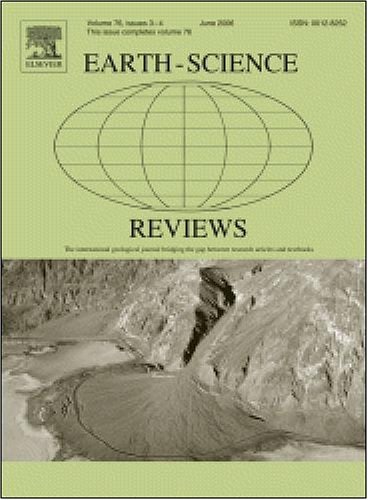暖始新世早期全球植被带与陆地气候
IF 10.8
1区 地球科学
Q1 GEOSCIENCES, MULTIDISCIPLINARY
引用次数: 0
摘要
始新世早期是一个关键的地质时间间隔,可以进一步了解在大气二氧化碳浓度超过800 ppmv的情况下的气候变化和生物圈变异,到本世纪末,在非常高的排放情景下,二氧化碳浓度可能达到800 ppmv以上。植被在全球碳循环和气候中起着至关重要的作用,未来与高大气CO2相关的变暖将改变现代植被模式和生物群落分布,从而影响植被-气候反馈。在这里,我们提出了迄今为止最全面的全球植被综合和定量陆地气候估计,汇编了193个古植物学地点,涵盖早始新世(伊波斯;56.0 - -47.8 Ma)。这些古区系的区系成分被翻译成41种植物功能类型(PFT),并被统计归类为古生物群系。此外,我们还利用叶片物候和灌木和旱生植物的PFT百分比来评估植被开放度。我们的全球生物群落重建和定量气候估计表明,随着纬度温度梯度的减小,全球变暖和总体变湿,气候季节性作为始新世早期生物群落分布的环境控制的重要性。由深度时间模式比对项目(DeepMIP)气候模式驱动的基于代理的重建结果与植被模式BIOME4的输出结果比较,在热带低纬度和高纬度地区显示出良好的一致性。然而,覆盖大部分亚热带和中纬度地区的替代重建森林和林地与模拟干灌丛和沙漠之间的广泛差异,揭示了我们对始新世早期水文循环和/或植被-气候相互作用的理解存在根本差距。本文章由计算机程序翻译,如有差异,请以英文原文为准。
Global vegetation zonation and terrestrial climate of the warm Early Eocene
The early Eocene is a key geological time interval to further our understanding of climate change and biosphere variability under high atmospheric CO2 concentrations of more than 800 ppmv that could potentially be reached by the end of this century under very high emission scenarios. Vegetation plays a crucial role in the global carbon cycle and climate, and future warming associated with high atmospheric CO2 will alter modern vegetation patterns and biome distribution, consequently affecting vegetation-climate feedbacks. Here we present the most comprehensive global synthesis of vegetation and quantitative terrestrial climate estimates to date, compiled for 193 palaeobotanical locations, covering the early Eocene (Ypresian; 56.0-47.8 Ma). The floristic components of these palaeofloras are translated into 41 Plant Functional Types (PFT) and statistically grouped into palaeo-biomes. In addition, we used leaf phenology and PFT percentage of shrubs and xerophytes to assess vegetation openness. Our global biome reconstruction and quantitative climate estimates show a warmer and overall wetter world with reduced latitudinal temperature gradients and highlight the importance of climate seasonality as environmental controls of early Eocene biome distribution. A comparison of proxy-based reconstructions with outputs of the vegetation model BIOME4, driven by climate models of the Deep-Time Model Intercomparison Project (DeepMIP), show general good agreement at low intertropical and high polar latitudes. However, widespread discrepancies between proxy reconstructed forests and woodlands and modelled dry shrublands and deserts, covering most of the subtropics and mid latitudes, reveal fundamental gaps in our understanding of the early Eocene hydrological cycle and/or vegetation-climate interaction.
求助全文
通过发布文献求助,成功后即可免费获取论文全文。
去求助
来源期刊

Earth-Science Reviews
地学-地球科学综合
CiteScore
21.70
自引率
5.80%
发文量
294
审稿时长
15.1 weeks
期刊介绍:
Covering a much wider field than the usual specialist journals, Earth Science Reviews publishes review articles dealing with all aspects of Earth Sciences, and is an important vehicle for allowing readers to see their particular interest related to the Earth Sciences as a whole.
 求助内容:
求助内容: 应助结果提醒方式:
应助结果提醒方式:


